There’s no question that minivans offer the best combination of passenger and cargo space in the smallest package, but which minivan is the best in the segment?
Although the Chrysler Pacifica has been out for over a year now, people are still shocked by how big a leap it made from the Town & Country it replaced, becoming a luxurious option brimming with technology.
However, new minivans don’t come along every day, so we had to wait for a worthy competitor before we threw it into a comparison.
ALSO SEE: Minivan vs Crossover
Well, that competitor has arrived, as Honda launched an entirely redesigned Odyssey this year, and it introduces a whole new infotainment system to go along with their usual refined, efficient drive and practical interior.
Although a plug-in hybrid Pacifica is available, we stuck with just the conventional gas engine for this comparison to keep the powertrains and price on even footing.
Get the Flash Player to see this player.
Seating & Practicality
When it comes to cargo capacity, both the Odyssey and Pacifica are big winners.
Although the Pacifica has a few more inches of wheelbase than the Odyssey, they are within an inch of each other in all other dimensions, so their cargo capacities are also identical for all intents and purposes. The trunk wells behind the third rows offer over 32 cubic feet, and with the third row folded, each has at least 85 cubic feet of space, and maximum cargo space of 140 cubic feet.
As to convenience, the Pacifica definitely has the ease-of-use advantage, with a power-folding third row and second-row seats that fold flat into the floor without having to struggle to remove them. While the third row of the Odyssey is manual, it is also quick and easy to fold (as are non-power versions of the Pacifica’s third row), but if you need the full 140 cu-ft of cargo space, you have to wrestle and remove the heavy second-row seats and then find somewhere to store them.
ALSO SEE: 2018 Honda Odyssey Review
The Pacifica’s seats are comfortable in the first two rows, with heated and cooled seats in front. The third row is a bit cramped for adults of course, but still decent for anyone that’s not huge, and is far better than any three-row SUV, both for seating comfort and accessibility. However, the Pacifica has overlooked one small issue with its ‘LATCH’ anchors in the second row – a plastic surround that obstructs the seat latch from locking to the anchor – I found it to be a frustrating nuisance. However, once installed, the child seats can stay in there pretty much forever since the seats can flip up and tilt forward to allow easy access to the third row, a trade-off I would gladly accept.
Headroom and legroom in the Odyssey are good for adults in all three rows, and like the Chrysler, the four main seats are comfortable, but the Odyssey’s seats are a bit more comfortable than those in the Pacifica, and the third row does have a bit more head and legroom. The Odyssey’s second row doesn’t fold into the floor or flip and tilt like the Pacifica’s, but it can slide from side to side with the middle section removed, making it easier to get into the third row between the seats without waking your sleeping kids in their child seats.
Compare Specs
Quality & Tech
One of the most impressive upgrades in the Pacifica is interior quality, with soft touch plastics, soft leather, and REAL stitching on the steering wheel and dash, giving it a legitimately luxurious feel.
Another feature that makes the Pacifica feel a class above is Chrysler’s UConnect infotainment system. With quick screen response, sharp graphics, an easily configured home screen and shortcuts for quick access to favorite functions, it requires barely a thought when switching between music sources, making a quick call, or adjusting the temperature. Android Auto/Apple CarPlay were not included with early 2017 models, but will be standard in 2018 models and 4G LTE Wifi Hotspot capability is featured in most trims, while Wifi hotspot is reserved for only the top model in the Odyssey.
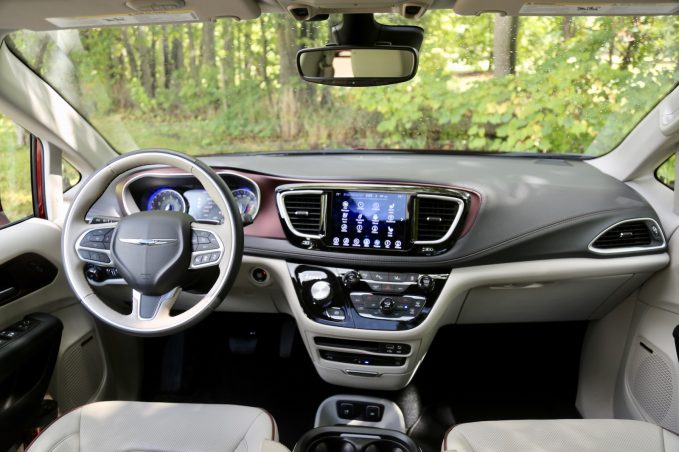
And because the Pacifica has those seat-mounted rear passenger touchscreens with built-in apps and games, you still get the massive panoramic sunroof for stargazing if kids can tear their eyes away from the screens for even one second.
The new Odyssey also features good quality materials, but the leather’s not as nice and the dash stitching is fake, so it’s very sensible, though not as luxurious as the Pacifica.
ALSO SEE: 2018 Chrysler Pacifica Adds Unlimited Wi Fi for $20 a Month
Thankfully, the touchscreen is quicker and more responsive than previous Honda offerings, and the layout is way better, so it’s really easy to navigate the system. And a volume knob! Praise whatever deity you pray to for leading Honda to the re-discovery of the volume knob, and I loved how easy it was to reconfigure the homescreen with your favorite apps and features.
Although we’ve long been fans of Uconnect, Honda might have actually finally turned the corner and delivered a modern, competitive infotainment system that does not suck and make grown men throw tantrums of rage because of its annoying delays and dumbass menu setup.
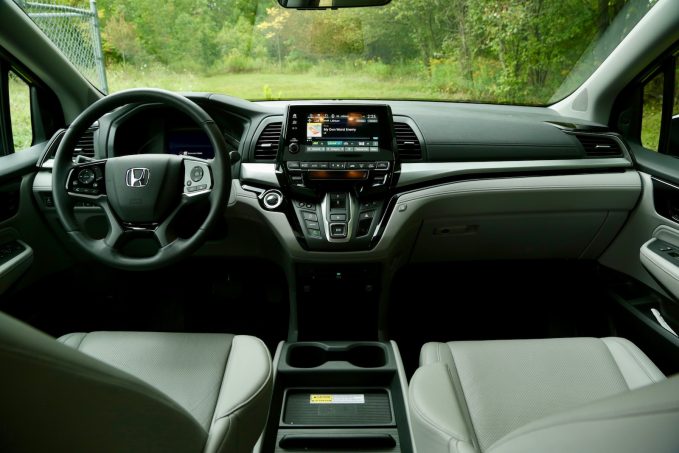
Scrolling through the list of features that both cars offer is both exhausting and frustrating since most of them are the same, right down to the fact that both have built-in vacuums!
However, HondaEyeofGod and HondaVoiceofGod are cool features that allow you to watch the kids from a roof-mounted camera and override their entertainment audio and speak into their headphones like some omnipotent, all-seeing parent.
Honda also has slightly better cabin storage, but you won’t be hurting for cupholders, bottle holders and little cubbies for your junk in either of these family rides.
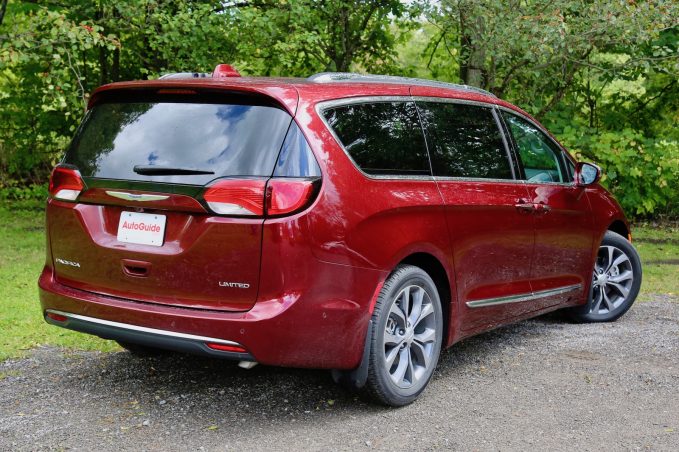
Driving Impressions
Even though these two vans make about the same amount of power, the Pacifica feels more powerful and responsive, mainly thanks to the fact that it weighs over 250 pounds less than the Odyssey.
The Pacifica’s 3.6L V6 makes 287 hp and 262 lb-ft of torque, and throttle is sharp enough that you will chirp the tires in the rain if you’re not careful. On the one hand, it has a bit of a nice growl when you’re getting up to speed, but some might find it a bit coarse, especially compared to the silky smooth Honda.
With drastic weight savings getting the Pacifica down to 4,330 pounds (1,964 kg) and a 9-speed automatic transmission, the Pacifica earns very respectable fuel economy ratings of 19 mpg in the city, 28 on the highway and 22 combined (12.9 L/100 km city, 8.4 highway, 10.9 combined), it should prove far more efficient than any SUV that can compete with it for interior space. That 9-speed was smooth enough during me time in it and didn’t display any of the issues that cropped up in various Jeeps when it first launched, but it’s still an area of concern for any FCA products, although Honda seems to be having its own problems with their nine-speed transmission.
ALSO SEE: 2017 Chrysler Pacifica Hybrid Review
The Odyssey makes plenty of power so it gets going just fine, but it weighs a hefty 4,600 pounds (2,083 kg), but the 3.5L V6 makes 280 horsepower and 262 lb-ft of torque, so while it might not be as fast as the Pacifica, it is quick enough to get out of its own way and the 10-speed automatic finds lower gears quickly to make passing maneuvers without concern. However, the button shifter does take some getting used to, especially when trying to make a three-point turn and resetting your brain to look for a tucked away button for reverse instead of slotting a gear lever forward and back. That being said, the Pacifica’s rotary dial shifter requires a similar adjustment period, and the jury is still out as to which is less annoying to get used to.
When it comes to efficiency, the Odyssey is rated at the exact same 19 miles per gallon in the city, 28 on the highway and 22 combined (12.2 L/100 km city, 8.5 highway, 10.6 combined), but Honda comes closer to achieving that in the real world, showing 21 mpg (11.8 L/100 km) on its trip computer compared to 20 (11.2 L/100 km) for the Pacifica from my time in it.
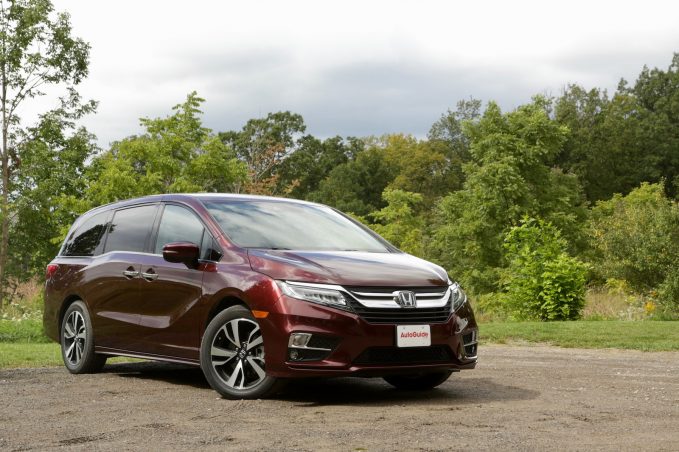
Comfort and Handling
The Pacifica doesn’t just feel more powerful, it also is easier to drive because it feels a bit smaller, making it easier to maneuver in parking lots and around town.
The Pacifica feels very comfortable as well and has a bit of a soft ride, which means it does get a bit tippy in the corners if you take them with a bit of speed, but it’s just enough to keep you out of trouble and not disconcerting in any way.
Out on the highway, the Pacifica is smooth and quiet, and the adaptive cruise control follows along in traffic at any speed, right down to a full stop, whereas Honda’s system cuts out below 20 mph, so it won’t crawl along in traffic and ease your hectic commute. Adaptive cruise isn’t the only driving tech in the Pacifica, and Rear Park Assist with Stop, Blind-spot Monitoring and Rear Cross Path detection are standard, while 360-degree Surround View camera, Perpendicular Park Assist, and Forward Collision Warning-Plus are available on higher trims along with that adaptive cruise.
A quick check of IIHS records shows that both these minivans score Top Safety Pick+ ratings with Good scores across the board, except for the Pacifica’s child seat installation score.
ALSO SEE: 2018 Honda Odyssey Earns Highest Safety Ratings from Both Agencies
The Odyssey, like any minivan, may not be great to drive, but it is super-comfortable, so it’s really easy to just get on the highway put on the Adaptive Cruise and let it just eat up the miles. However, as mentioned earlier, the adaptive cruise cuts out at lower speeds, which is a disappointment when you are stuck in stop-and-go traffic, but it too has enough active safety systems that should keep you out of trouble in tight parking lots or in moments of inattention when handling family crises.
Although the Odyssey is actually narrower than the Pacifica, it feels extra wide because of all that weight, so while it does seem more stable driving along on the highway, it also feels ungainly, like a big fat barge slowly wallowing through corners.
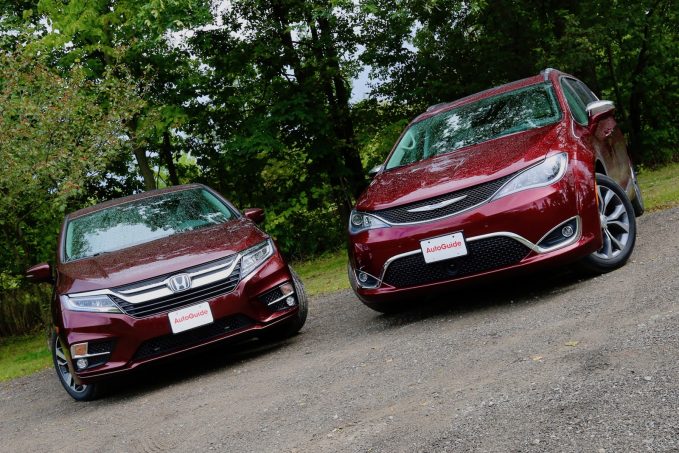
The Verdict: Honda Odyssey vs Chrysler Pacifica Comparison Test
The new Odyssey is truly a great minivan made even better with the latest round of updates that Honda executed.
It’s practical through and through, they’ve maintained their leadership in efficiency, and it’s powerful enough that you won’t feel like you lag behind traffic, all while feeling refined to drive. With plenty of space for passengers and cargo and little practical touches that make it easy to live with, it’s comfortable inside and on the road, but the greatest improvement is an infotainment system that will fit seamlessly into your driving habits without causing irritation. Unfortunately, while it is practical, the second-row seats aren’t as flexible for maximum cargo capacity or third row access, and it sometimes feels like a whale to drive, two things that, I admit, many people might not care about.
ALSO SEE: How the Chrysler Pacifica Gets Made
The Pacifica beats the Odyssey on those two last points, in particular, feeling peppy and eager to drive, even in corners, although the engine and ride might not be as refined. However, the Pacifica’s interior also felt and looked more luxurious, with those dual screens representing a huge appeal for kids, and second-row seats that not only stow, but also flip out of the way for third-row access, making the best use of all that space that minivans promise. Aside from Chrysler’s reputation for questionable reliability, my other main complaint is that the Pacifica can get really pricey, hitting over fifty thousand dollars fully loaded (as tested, this model would cost $50,120 including $1,095 freight in the US or $61,595 including $1,795 freight in Canada), so it’s hard to accept paying that much for ANY minivan, even one as luxurious and well equipped as this.
After spending the better part of two weeks with these two minivans, the Chrysler Pacifica is the one my family wanted to keep.
The kids loved the dual screens, I liked the way it drives better, and it is just as practical as the Odyssey with a few more conveniences that make life easier for families.
Honda Odyssey
Chrysler Pacifica



Leave a Reply